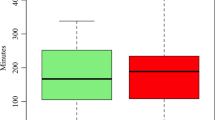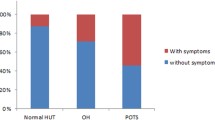Abstract
Objectives
This study was designed to examine the effect of head-up sleeping as a treatment for vasovagal syncope in otherwise healthy patients. Treatment for syncope is difficult. Pharmacological treatments have potential side effects and, although other non-pharmacological treatments such as salt and fluid loading often help, in some cases they may be ineffective or unsuitable. Head-up sleeping may provide an alternative treatment.
Methods
Twelve patients had a diagnosis of vasovagal syncope based both on the history and on early pre-syncope during a test of head-up tilting and graded lower body suction. They then underwent a period of 3–4 months of sleeping with the head-end of their bed raised by 10°, after which orthostatic tolerance (time to pre-syncope during tilt test) was reassessed.
Results
Eleven patients (92%) showed a significant improvement in orthostatic tolerance (time to pre-syncope increased by 2 minutes or more). Plasma volume was assessed in eight patients and was found to show a significant increase (P < 0.05, Wilcoxon signed-rank test). There was no significant change in either resting or tilted heart rate or blood pressure after head-up sleeping.
Interpretation
Head-up sleeping is a simple, non-pharmacological treatment which is effective in the majority of patients. However, it may not be tolerated by patients or bed-partners long term and whether the effects continue after cessation of treatment remains to be determined.





Similar content being viewed by others
References
Brignole M, Alboni P, Benditt D et al (2001) Guidelines on management (diagnosis and treatment) of syncope. Eur Heart J 22:1256–1306
Brown CM, Hainsworth R (2000) Forearm vascular responses during orthostatic stress in control subjects and patients with posturally related syncope. Clin Auton Res 10(2):57–61
Claydon VE, Hainsworth R (2003) Cerebral autoregulation during orthostatic stress in healthy controls and in patients with posturally related syncope. Clin Auton Res 13(5):321–329
Claydon VE, Hainsworth R (2004) Salt supplementation improves orthostatic cerebral and peripheral vascular control in patients with syncope. Hypertension 43(4):809–813
Claydon VE, Hainsworth R (2005) Increased postural sway in control subjects with poor orthostatic tolerance. J Am Coll Cardiol 46(7):1309–1313
Claydon VE, Hainsworth R (2006) Postural sway in patients with syncope and poor orthostatic tolerance. Heart 92(11):1688–1689
Colman N, Nahm K, Ganzeboom KS et al (2004) Epidemiology of reflex syncope. Clin Auton Res 14:I9–I17
Cooper VL, Fuentealba P, Hainsworth R, McIntosh SJ (2006) Is simple advice all that is needed to manage patients with syncope? Clin Auton Res 16:341 (abstr)
Cooper VL, Hainsworth R (2002) Effects of head-up tilting on baroreceptor control in subjects with different tolerances to orthostatic stress. Clin Sci (Lond) 103(3):221–226
Cooper VL, Hainsworth R (2002) Effects of dietary salt on orthostatic tolerance, blood pressure and baroreceptor sensitivity in patients with syncope. Clin Auton Res 12(4):236–241
El-Bedawi KM, Hainsworth R (1994) Combined head-up tilt and lower body suction: a test of orthostatic tolerance. Clin Auton Res 4(1–2):41–47
El-Sayed H, Goodall SR, Hainsworth R (1995) Re-evaluation of Evans blue dye dilution method of plasma volume measurement. Clin Lab Haematol 17(2):189–194
El-Sayed H, Hainsworth R (1996) Salt supplement increases plasma volume and orthostatic tolerance in patients with unexplained syncope. Heart 75(2):134–140
Gilbert CA, Stevens PM (1996) Forearm vascular responses to lower body negative pressure and orthostasis. J App Physiol 21:1265–1272
Hainsworth R, El-Bedawi KM (2004) Orthostatic tolerance in patients with unexplained syncope. Clin Auton Res 4(5):239–244
Kapoor WN (2000) Syncope. N Engl J Med 343:1826–1856
Lassen NA (1959) Cerebral blood flow and oxygen consumption in man. Physiol Rev 39:183–238
Mtinangi BL, Hainsworth R (1998) Increased orthostatic tolerance following moderate exercise training in patients with unexplained syncope. Heart 80(6):596–600
Mtinangi BL, Hainsworth R (1998) Early effects of oral salt on plasma volume, orthostatic tolerance, and baroreceptor sensitivity in patients with syncope. Clin Auton Res (4):231–235
Mtinangi BL, Hainsworth R (1999) Effects of moderate exercise training on plasma volume, baroreceptor sensitivity and orthostatic tolerance in healthy subjects. Exp Physiol 84(1):121–130
Olsen H, Lanne T (1998) Reduced venous compliance in lower limbs of ageing humans and its importance for capacitance function. Am J Physiol 275:H878–H886
Pathak A, Raoul V, Montastruc JL, Senard JM (2005) Adverse drug reactions related to drugs used in orthostatic hypotension: a prospective and systematic pharmacovigilance study in France. Eur J Clin Pharmacol 61(5–6):471–474
Conflict of interest statement
There are no conflicts of interest.
Author information
Authors and Affiliations
Corresponding author
Rights and permissions
About this article
Cite this article
Cooper, V.L., Hainsworth, R. Head-up sleeping improves orthostatic tolerance in patients with syncope. Clin Auton Res 18, 318–324 (2008). https://doi.org/10.1007/s10286-008-0494-8
Received:
Accepted:
Published:
Issue Date:
DOI: https://doi.org/10.1007/s10286-008-0494-8




